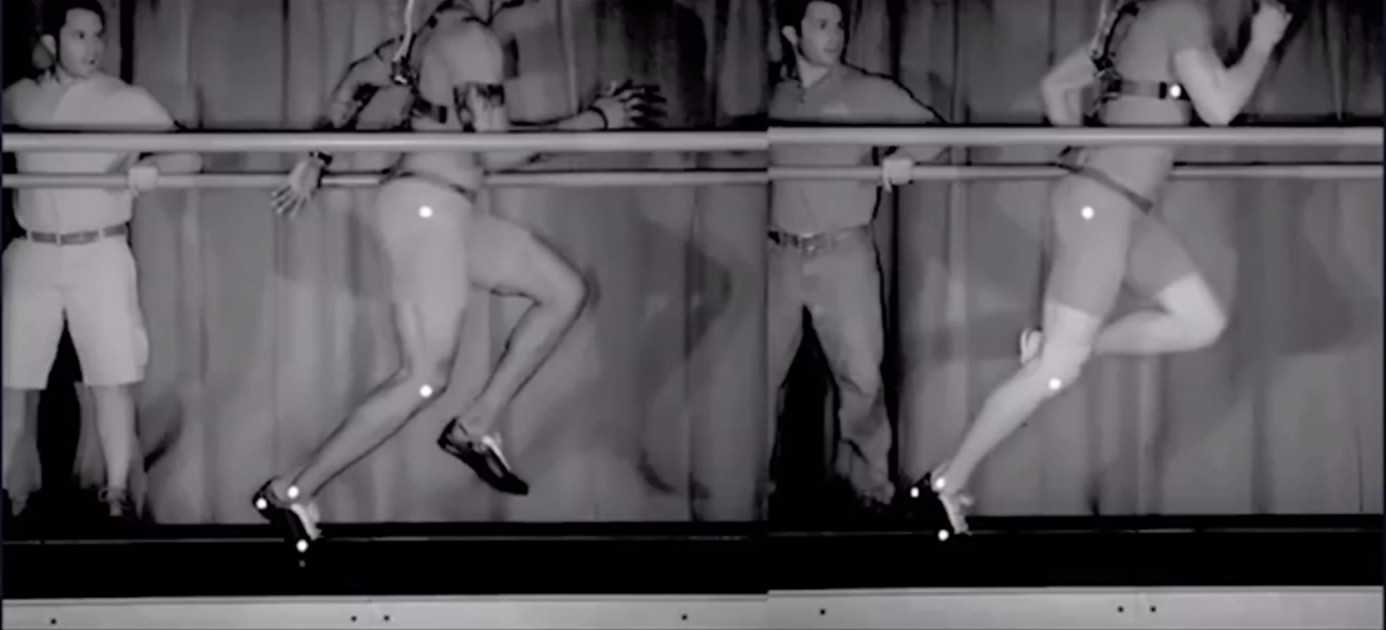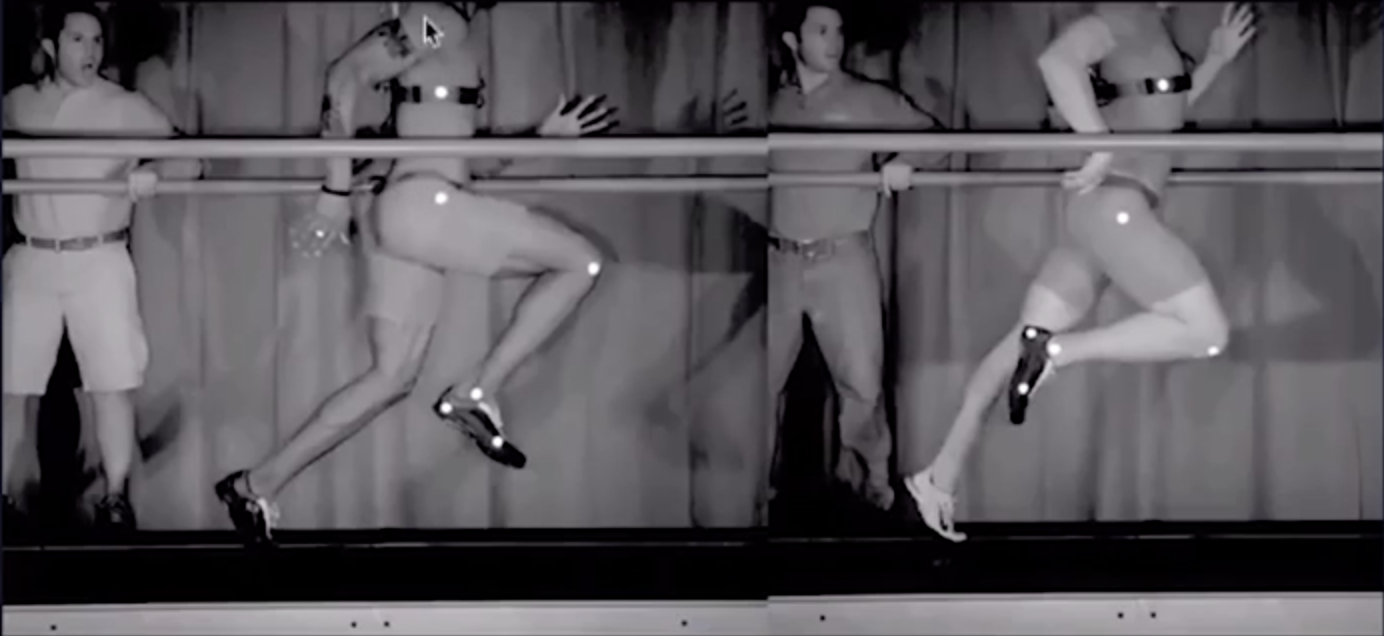The Glute Is Only As Good As The Soleus And Hamstring Allow It To Be
Below is a slide I use in my return to play courses. As you can see we have two sprinters, the one on the left is an olympic sprinter and the one on the right is a collegiate sprinter.
This video really demonstrates where our rehab needs to be going. This short clip can show you a lot about how I go about building my return to play system.
Two Sprinters
The biggest mistake I see is therapists not following the contour of the upper ankle. If you strap straight across you’ll often end up with a wrinkle in the tape. Angling the tape at the start will produce a smooth wrap. This strap is your anchor.
Compare each athlete’s torso. As you see the athlete on the right’s rib cage is protracted. He has an elevation in that rib cage which has a reaction at his pelvis.
On the left, some might say they have weak abdominals or a weak core but that doesn’t really make sense.

Asking Why
The one point I would like to make is it is very easy for us as therapists to say weak glutes. But the real thing I preach is asking these higher level questions and asking why. Why is this person currently using this movement strategy?

Adductor, sartorius and medial hamstring in a sprinter
When assessing the sprinter on the left, look closely at the reactions as the foot hits the floor. Just before the foot hits the floor you can see how much the adductor, sartorius and medial hamstrings are all working together. The pre-tension before the foot hits the floor is all in place. As the foot hits the floor you can see a nice co-contraction of the leg. Most of this is happening subconsciously.
Hamstring, gastro and quad allowing the glute to work
Now, as the right foot hits the floor, look at where the pressure is on his foot. In this position the hamstrings, gastrocnemius and quadriceps are all working together to allow the glute to do its job. And this is something I always say…
The glute is only as effective as the hamstring and the gastroc allows it to be.

Sprinter knee extension in physiotherapy
As you can see above, when looking at the sprinter on the left, the hip extends with very little knee extension. This is most likely a reaction to his pelvis and torso but I would again say is not weak abdominals.
What is happening on the right versus left? The athlete on the right snaps back quickly which then alters the length tension relationship of the glutes. This then causes a lot of work at the knee. If the knee snaps back as the body weight goes forward most of the work is done at the knee.
As you can see the athlete on the left is delaying knee extension. The two muscles that delay knee extension are the hamstring and proximal gastrocnemius. In this position, the knee isn’t doing the work, the majority of the work is being done by the hip and the foot before the toe off and then the knee extends. The glute is very reliant on the hamstring and gastrocnemius to co-contract with the quadriceps. The knee shouldnt be extending too early in this way. If you look at patients with osteoarthritis you’ll see exactly this.
Delaying Knee Extension
A big part of my rehab is trying to get the glutes to be successful by delaying knee extension. If we delay knee extension then the hip does more work, if it snaps back then the knee is working harder with the glutes in a shorted position where they have to produce a lot more energy to do the same work.
The Rib Cage

Elevated rib cage in sports physiotherapy
Let’s take another look at this torso. Above you see the elevated rib cage and protracted ribs which will cause a big reaction at the pelvis. So why is this happening?

Diaphragm lengthening in professional sports physiotherapy
The Diaphragm
Above we see what happens when we get stressed. When we inhale the diaphragm shortens when we exhale it lengthens. When you inhale and shorten the diaphragm you will go into the position we see with the athlete we observed on the right.
Ask yourself, is the speed of his movement stressing the nervous system and are they having a reaction?
When we go into fight or flight we increase our breathing rate and lose the ability to lengthen the diaphragm. When we do lengthen it our transverse abdominis or rectus abdominis are at a much better length tension relationship. So, if we need this athlete to keep their ribcage down we need the diaphragm to lengthen and the pelvic floor to ascend which will automatically help the abdominals be successful.
If we lose the ability for the diaphragm to lengthen, the lower back and the hamstrings will feel tight but may not necessarily be tight.
Signs of increasing sympathetic dominance
- Breathing rate increases
- Diaphragm depth decreased movement (mouth breathing)
- Protective postures and movements
- Decreased movement variability => rib cage movement
- Rigidity => Ribcage generally
- Poor weight distribution through the foot
- Poor control of breath with movement
Final Thoughts
This thought process is the basis of my rehab program whether it is for a professional athlete or a non-sporting private practice patient.
When the knee is working we want everything else to contribute. Most of the energy happens below the knee so it needs to be set up for success. If we delay the extension then the glute will be able to work a lot better. If the knee extends quicker it will be doing more work
So what can we take from this? Do not become obsessed with blaming or treating the glutes. There is far more at play than you may think at first.
For more information on how these systems work click here.

